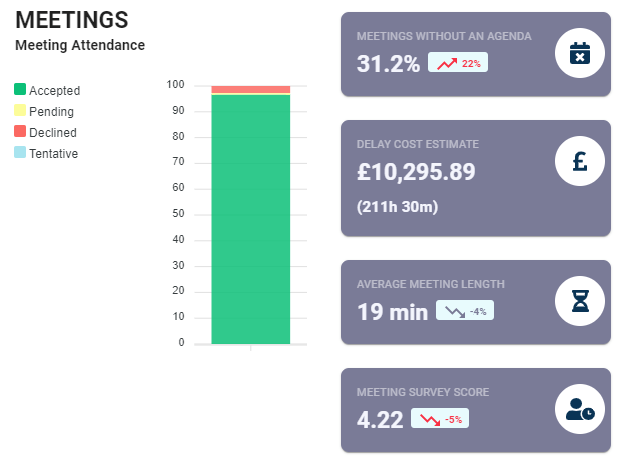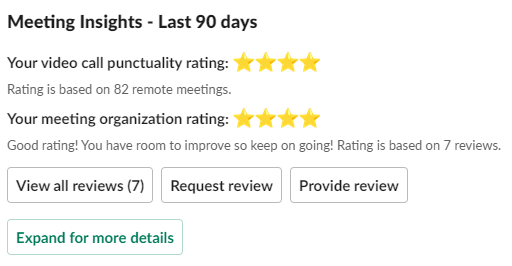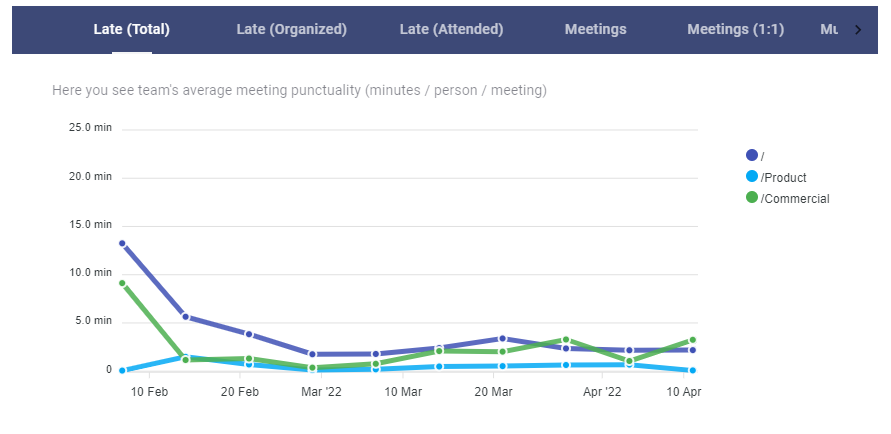Late meetings are a common occurrence in many workplaces. They can have a significant impact on productivity and cost businesses money. Whether it's physical office meetings or video meetings on platforms like zoom, team lateness can be frustrating for everyone involved.
Most businesses are unaware of how much money meeting punctuality is costing them, and those that are aware, are not measuring lateness effectively. There are easy steps that can be taken, and tools (such as Flowtrace), that can be used to measure and improve meeting punctuality.
More than half (56%) of all employees admit failing to attend meetings and other work events on time at least once a week.
How Much Does Meeting Lateness Cost Companies?

Flowtrace client's meeting lateness cost estimate (smal team).
Traditionally it can be difficult to calculate the cost of meeting lateness because there are so many variables. The type of meeting, the size of the team, and even the location can all impact how much money is being wasted.
A recent study by Harvard Business Review found that late meetings cost businesses an average of $15 million per year.
The study also found that most people believe punctuality is important, but only a third of respondents said they were always on time for meetings. This indicates that there is room for improvement when it comes to meeting punctuality.
Breaking this down on a company level, we looked at these numbers in a recent Zoom analytics article:
For example, if an employee is on average 5 minutes late to a meeting, and this happens 5 times a week, that leads to about 20 hours of wasted time on a yearly basis. This waste doesn’t even include the wasted preparation time, potential rescheduling costs, or overrunning meeting times, so in reality, the wastage is a lot higher.
When considering punctuality only as a factor, this can be broken down into a minute factor:
Multiplying the above individual cost estimate with a team of 50 people, that's 940 hours per year wasted. If you have a team of 100 people, that's whopping 1900 hours wasted in the entire year. That’s a complete full-time employee’s work effort worth of time wasted just from being late to meetings.
This is a major issue for companies and can end up costing millions depending on the size of the team. By addressing punctuality as the main cause, other time wasted on organization, supplies, etc. can be automatically resolved. If a team is motivated to be punctual for a meeting, other areas of the meeting conduct will improve as well.
One way to address this is by setting a goal for the team to be on time for meetings, every time. This may seem small, but it can have a major impact. If the team is on time for meetings, they are more likely to be on time for other tasks and deadlines.
This can be solved in one simple step, using a punctuality rating system that's automated. Flowtrace offers this solution that not only has a positive impact within weeks but also doesn’t require any manual involvement from the management.
Almost a quarter of workers (23%) said they perform badly in meetings after arriving late according to the Independent.
How is Meeting Punctuality Currently Measured?
There are a few different ways that companies are measuring meeting punctuality, but they may not be following meeting best practices. The most common way is simply observing employees and how often they are on time for meetings. This method is not very effective because it is prone to error and people are not always honest to themselves.
Another way they are measuring meeting punctuality is to use an attendance tracking system. This can be done with physical sign-in sheets or electronic systems. This method is more accurate than asking people, but it still has its flaws. For one, it only tracks whether or not someone was present for the meeting, not if they were late.
Finally, meeting organizers can also manually note down the arrival time of meeting attendees, which is very tedious and prone to human error, and also not effective to take action upon. This is also dependent on the individual, with no unified standards, and hence could be recorded incorrectly. It is a near impossible task to aggregate manually entered attendance time to keep the company's wider metrics accurate and trustworthy.

How Can Meeting Lateness be Measured

Meeting lateness is usually identified as part of performance review cycles, or in 1-to-1 meetings, where managers are able to easily separate the individual team members who are naturally on time and naturally late. When this issue is evident to management, it can be addressed with the employees on an individual basis but not on a team basis.
Some companies will also standardize this into their culture and address any meeting lateness through 1-to-1 meetings, and formal performance reviews. This can be problematic for companies and lead to inaccurate punctuality observations; linking back to the wasted time in meetings and cost to the company, this would go unnoticed without a proper measurement solution.
As it stands, when it comes to meeting punctuality itself, measuring punctuality is currently carried out using outdated and ineffective methods. There is usually no automated system of a record which spews these numbers out to help improving company's punctuality culture.
Taking the example of a sign-in sheet for a meeting, employees often forget to sign the sheet manually or would forget to move this to central databases; this would go unnoticed by management and lead to incorrect data if they were to identify meeting punctuality.
More often than not, companies are not tracking meeting lateness at all. With a lack of awareness of the facts, in terms of cost and time wasted due to punctuality, some companies do not address punctuality in meetings on any level. In a large company of hundreds of employees, this can be catastrophic in terms of time and money wasted.
The overall point is that companies may choose not to measure meeting punctuality due to time wasted in manual data observations, gathering, and its inaccuracies, which is ironic as they are losing money by not getting on top of meeting delay costs. The companies that are measuring lateness do not have the right tools and usually, nothing is automated.
That’s where Flowtrace revolutionizes meeting punctuality standards; with an automated solution that gamifies lateness with punctuality scores, putting the motivation into the individuals and teams to improve, without manual input from management.
Redefining Meeting Punctuality with Flowtrace

Flowtrace offers a unique and refreshing insight into meeting punctuality. With its punctuality rating score, you can not only see your personal punctuality record but also which teams are regularly late for meetings, but also how much time is being wasted as a result.
This way, you can identify which meetings, or departments are causing the most lateness and take steps to improve punctuality. As individuals are able to see their own punctuality scores, this gamifies their presence to being on time, motivating the individual to improve without ‘strict’ oversight from management or direct action needing to be taken. Team members are actually able to compare their punctuality score with each others, monitor their own ranking score over time, and also see how their team is scoring collectively.
With these metrics available to the individual team members and teams, it creates an empowering solution to punctuality through passive action. We often see drastic improvements in first weeks of using Flowtrace.

What's more, Flowtrace doesn't just measure meeting punctuality - it also offers tips on how to improve meeting organization skills, and improve productivity, and how to collaborate better. So not only will you be able to save time and money, but you'll also be able to make your meetings more effective at decision making.
If you're ready to improve your meeting punctuality, start using Flowtrace today. It's free to try and only takes a few minutes to set up.

How to Reduce Meeting Lateness Costs
Meeting lateness ultimately starts by being example-led and set within the company culture. If teams see that management is constantly 5-10 minutes late for meetings, they will not rush to be there on time as they know that there are always ‘5-10 minutes’ they have to play with. This sets a bad example and starts to become a part of a negative company culture which is hard to rectify.
There are a few different methods that can be carried out to reduce meeting lateness and the costs associated:
First, you can try to schedule meetings at times when people are less likely to be late. For example, you could schedule meetings during given “standard meeting hours”, meeting days, or at quieter times like towards the end of the day.
Second, you can hold all virtual meetings instead of hybrid in-person meetings. This would eliminate the need for travel time and would also be more convenient for employees who have busy schedules. This puts everyone on the same footing meanwhile ensuring the meetings are designed for everyone equally.
Third, you should use your calendar system to set standard event times to include a buffer after the meeting. For a 30 mintute call, set the default scheduled as a 25 minutes, and for a stadard 60 minute call, set the standard length as a 50 minutes. This builds natural buffer to whole of your team.
Finally, you can use Flowtrace to help identify which meetings and teams are borne the most lateness costs and take steps to understand and analyze if there are any trend patterns emerging for functions, geographical areas, or teams. This will allow you to test different strategies for future meetings and observe the impact of changes with ease.
Conclusion
Late meetings are a huge cost for companies, both in terms of time and money. However, there are ways to reduce the impact of late meetings by measuring their punctuality and taking steps to improve it. Flowtrace has seen effective results in just days, for teams to be motivated to improve punctuality when provided with effective tools.
Furthermore, when the entire company, including leadership, is behind using a tool to improve punctuality, it can reap huge rewards for the team and business.
